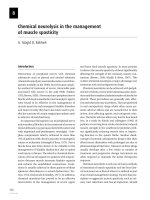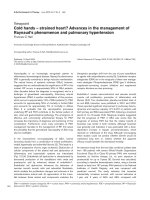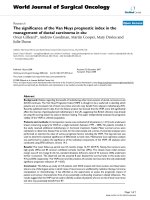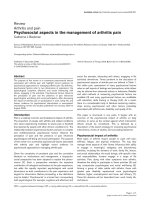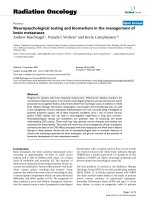Application of technology in the management of distribution system at habeco trading one member company limited
Bạn đang xem bản rút gọn của tài liệu. Xem và tải ngay bản đầy đủ của tài liệu tại đây (12.94 MB, 112 trang )
ĐẠI HỌC QUỐC GIA HÀ NỘI
KHOA QUẢN TRỊ VÀ KINH DOANH
---------------------
NGUYỄN THU NGA
APPLICATION OF TECHNOLOGY IN THE
MANAGEMENT OF DISTRIBUTION SYSTEM AT HABECO
TRADING ONE-MEMBER COMPANY LIMITED
ỨNG DỤNG CÔNG NGHỆ TRONG QUẢN TRỊ HỆ THỐNG
PHÂN PHỐI TẠI CÔNG TY TNHH MỘT THÀNH VIÊN
THƯƠNG MẠI HABECO
LUẬN VĂN THẠC SĨ QUẢN TRỊ KINH DOANH
HÀ NỘI - 2021
ĐẠI HỌC QUỐC GIA HÀ NỘI
KHOA QUẢN TRỊ VÀ KINH DOANH
---------------------
NGUYỄN THU NGA
APPLICATION OF TECHNOLOGY IN THE
MANAGEMENT OF DISTRIBUTION SYSTEM AT HABECO
TRADING ONE-MEMBER COMPANY LIMITED
ỨNG DỤNG CÔNG NGHỆ TRONG QUẢN TRỊ HỆ THỐNG
PHÂN PHỐI TẠI CÔNG TY TNHH MỘT THÀNH VIÊN
THƯƠNG MẠI HABECO
Chuyên ngành: Quản trị kinh doanh
Mã số: 8340101.01
LUẬN VĂN THẠC SĨ QUẢN TRỊ KINH DOANH
NGƯỜI HƯỚNG DẪN KHOA HỌC: PGS.TS. HỒNG ĐÌNH PHI
HÀ NỘI - 2021
DECLARATION
The author confirms that the research outcome in the thesis is the result of
author’s independent work during study and research period and it has not yet
published in other’s research and article.
The other’s research result and documentation (extraction, table, figure, formula,
and other document) used in the thesis are cited properly and the permission (if
required) is given.
The author is responsible in front of the Thesis Assessment Committee, Hanoi
School of Business, and the laws for above-mentioned declaration.
ACKNOWLEDGEMENT
First and foremost, I would like to express my faithful acknowledgement to
Hanoi School of Business, Vietnam National University (HSB, VNU) and all the
members, lecturers and assistants for knowledge and experience that has been taught
and shared through comprehensive and inspiring lectures, discussions and exams
throughout MBA 13 course.”
I would also want to extend my most sincere appreciation to my supervisor,
Assoc. Prof. Dr. Hoang Dinh Phi, whose vast knowledge and logical thought of
business management in general and technology field in particular has brought great
values and inspiration to me. His sharing of knowledge and experience has encouraged
and enable me to complete this MBA thesis.”
On the other hand, I would not be able to complete this thesis in its most practical
aspect without the strong support from my leaders and colleagues at Habeco Trading
One Member Company Limited, who are though very busy with business issues but
still spare their precious time and passion in responding thoughtfully to my interviews
and survey.”
Last but not least, I would like to grant my most heartfelt thanks to my family.
Without their encouragement and continuous support, I would have not been able to
focus on completing on my thesis, which is one of my biggest achievement of the
year.”
Table of Contents
ABBREVIATION..............................................................................................................i
LIST OF TABLES............................................................................................................ii
LIST OF FIGURES.........................................................................................................iii
TITLE CHAPTER.............................................................................................................1
1. Rationale................................................................................................................1
2.
Literature review..................................................................................................2
3.
Aims of research...................................................................................................4
4.
Objects of research...............................................................................................5
5.
Scope of research..................................................................................................5
6.
Research methodology.........................................................................................5
6.1
Research process.................................................................................................5
6.2
Data collection....................................................................................................6
6.2.1 Secondary data..................................................................................................6
6.2.2 Primary data......................................................................................................6
6.2.3. Data analysis....................................................................................................7
7.
Thesis structure.....................................................................................................7
CHAPTER 1: BASIC THEORY ON TECHNOLOGY APPLICATION IN THE
MANAGEMENT OF DISTRIBUTION SYSTEM..........................................................8
1.1
Overview of technology.........................................................................................8
1.1.1.
Definition of technology.....................................................................................8
1.1.2.
Classifications of technologies...........................................................................9
1.1.3.
Roles of technology in business........................................................................10
1.2
Overview of distribution system..........................................................................12
1.2.1.
Definition of distribution system......................................................................12
1.2.2.
Roles and functions of distribution system.......................................................12
1.2.3.
Distribution channel system management........................................................18
1.3
Technology application in the management of distribution system.....................21
CHAPTER 2: CURRENT SITUATION OF TECHNOLOGY APPLICATION IN THE
DISTRIBUTION SYSTEM MANAGEMENT AT HABECO TRADING ONE
MEMBER COMPANY LIMITED.................................................................................28
2.1
Overview of beer industry in Vietnam.................................................................28
2.2
Overview of Habeco Trading One - Member Company Limited........................32
2.2.1
History of development and establishment.......................................................32
2.2.2
Organizational structure....................................................................................34
2.3
Overview of distribution system at Habeco Trading One Member Co., Ltd.......38
2.4 Actual situation of management of distribution system in Habeco Trading One
Member Co., Ltd.............................................................................................................45
2.5
Current status of applying technology in distribution system management........58
CHAPTER 3: PROPOSAL OF SOLUTIONS FOR BETTER APPLICATION OF
TECHNOLOGY IN THE DISTRIBUTION SYSTEM MANAGEMENT AT HABECO
TRADING ONE MEMBER CO., LTD..........................................................................68
3.1
Selecting technologies for the management of distribution system.....................68
3.1.1
Objectives of application technologies for the management at Habeco..........68
3.1.2
Technologies for the management of distribution system................................68
3.2 Recommendations for the effective and efficient application of technologies for
the management of Habeco distribution system.............................................................85
CONCLUSION...............................................................................................................91
LIST OF REFERENCE..................................................................................................92
APPENDIX 1..................................................................................................................93
APPENDIX 2..................................................................................................................94
APPENDIX 3..................................................................................................................99
ABBREVIATION
HSB
MBA
VNU
HR
KPI
: Hanoi School of Business
: Master of Business Administration
: Vietnam National University
: Human Resources
: Key Performance Indicator
SMEs
: Small and medium enterprises
: Hanoi Beer Alcohol and Beverage Joint Stock Corporation
: HABECO Trading One Member Co., Ltd
: Fast Moving Consumer Good
: Distribution Management System
: Enterprise Resources Planning
: Solution Software Enterprise
: Area Sales Manager
: Sales Supervisor
: Sales Representative
: Point of sales material
: General Trade
: Modern Trade
HABECO
MTV HABECO
FMCG
DMS
ERP
SSE
ASM
SS
SR
POSM
GT
MT
1
LIST OF TABLES
Table 1: Information about number distributor & monthly revenue of MTV Habeco...42
Table 2: Information about the quantity of sales team in MTV Habeco........................56
Table 3: Survey on distribution management reporting system in MTV Habeco..........63
Table 4: Evaluation of The BOD's commitment to DMS project implementation........83
2
LIST OF FIGURES
Figure 1: Research process................................................................................................5
Figure 2: Technology Equation.........................................................................................9
Figure 3: Consumer distribution channel........................................................................15
Figure 4: Channel Flows in general................................................................................17
Figure 5: Five Flows in Marketing Channel for Beer.....................................................17
Figure 6: Situation of production and consumption of beer industry 2010 –2019.........28
Figure 7: Beer market share in Vietnam.........................................................................29
Figure 8: Forecast of Vietnam beer consumption...........................................................31
Figure 9: Revenue & Profit of Habeco from 2016 to 2019............................................33
Figure 10: Product consumption & Sales revenue of MTV Habeco from 2016 to 2019
.........................................................................................................................................34
Figure 11: Organizational chart of Habeco Trading One Member Co., Ltd...................36
Figure 12: Habeco Trading One Member’s staff qualification in 2020..........................37
Figure 13: Organizational chart of Branch in Habeco Trading One Member Co., Ltd..37
Figure 14: Model of distribution channel in MTV Habeco............................................38
Figure 15: Progress of restructuring distribution system in MTV Habeco....................40
Figure 16: The quantity of distributor in MTV Habeco.................................................41
Figure 17: Map of MTV Habeco Branch........................................................................42
Figure 18: The ratio of the area, the number of distributors and revenue between
branches in MTV Habeco...............................................................................................42
Figure 22: Model of Distribution system management applied in MTV Habeco..........45
Figure 20: Ordering flow & Product flow in Habeco.....................................................47
Figure 21: Price map of beer brands in the market.........................................................48
Figure 23: Push and Pull Marketing Strategy in MTV Habeco......................................49
Figure 24: Promotion flow in Habeco............................................................................50
Figure 26: The opinon of support policies for distribution system in comparison with
competitors......................................................................................................................52
3
Figure 25: Payment flow for promotion program in MTV Habeco...............................55
Figure 27: % personel division in MTV Habeco............................................................56
Figure 28: % of position in sales division in MTV Habeco...........................................57
Figure 29: DMS.One applied in MTV Habeco from 2014 to 2016................................61
Figure 31: Current model of Enterprise Resources Planning applied in Habeco...........82
4
TITLE CHAPTER
1. Rationale
Technology is all around us today and it must be admitted that technology is
impacting almost areas of our lives. Especially, in the business sector, there has been a
continuous growth over the last few decades due to the remarkable advancements of
technology. Business has existed since the beginning of the human race in the form of
simplistic barter, without technology business would not be the same as it is today and
major industries could have collapsed. Technology has made great progress in trade
and commerce. Business concepts and models have been revolutionized as technology
introduced a new and better approach to how business is going. Being more competent
than ever, the firms are continuously evolving themselves to make more profits, reachout to more customers and speed up their business processes. With the advent of
Artificial Intelligence, Machine Learning and Automation tools, businesses have been
improving their workflows.
The revolution 4.0 brings both opportunities and challenges to enterprises.
Updating new technology trends, changing management methods, automating systems,
updating and processing data quickly are what businesses are orienting toward.
Marketing, including distribution channels, also needs to adapt to this rapid change to
keep up with the market's shift from traditional marketing to 4.0 technology. Channels
of distribution are not merely the movement of physical products from place to place, it
helps to anticipate market demand, user tastes and product. No matter how good the
product, how impressive the marketing is, the business will not develop if the product
is not delivered. So in order to improve and maintain the distribution channel
effectively as well as to maximize revenues and profits, applying technology in
managing distribution channels is necessary. Technology will help to manage the work
flow easier and more scientific, promptly handle problems, optimize human resources
for businesses, contribute to a stable growth and increase value for the company.
The beer industry in Vietnam is a promising land for domestic and foreign
brewers. With the 8th position in Asia in terms of beer consumption volume in 2008,
after only 10 years, Vietnam has risen to 3rd position only after China and Japan with
an estimated beer consumption per capita of about 64.9 liters. This has strongly
1
attracted the attention of foreign investors. The strong growth and the population of 100
million people make Vietnam become an attractive fertile market for brewers.
As one of the three largest beer companies in Vietnam, Habeco is also aware of
the difficulties in the fiercely competition. From the end of 2016 to 2020, Habeco
implemented to restructure its distribution system. And now, it is time for Habeco to
change its traditional way of management, instead apply technology in distribution
system management to optimize and increase work. Technological solutions help
Habeco have the optimal automation and workflows that save time and personnel
resources for operation and cover more customers instead of recruiting more people.
Huge expenses in distribution for promotion, display, sales programs, POSM… are
strictly controlled on the system to help Habeco resolve negative issues, budget losses
and ineffectiveness in deploying these programs.
For those reasons, the researcher chose the subject "APPLICATION OF
TECHNOLOGY IN THE MANAGEMENT OF DISTRIBUTION SYSTEM AT
HABECO TRADING ONE-MEMBER COMPANY LIMITED" to study and put
into practical application at Habeco to improve distribution activities for beer products
and its competitiveness in the market.
2. Literature review
The author has searched and reviewed articles to clarify the crucial role of
technology and distribution channel in business.
In the article on Distribution Network and the Role of Information and
Communication Technologies (2010), Lutfu Sagbansua & M. Nurettin Alabay
mentioned “Distribution as a function of marketing, consisting distribution channel
management and physical distribution, has significantly improved the physical
distribution as a result of developments in the field of information and communication
technologies”. The role of information technology in distribution system management
is increasing. If in the past, information technology was only considered as an
additional value to the company, in the modern technology development era it has
become a must-have tool to help the company compete in the market. When operating
processes have reached maximum productivity, companies need to find solutions to
reduce costs in order to increase profitability. Information technology will help
2
businesses: to increase sensitivity to the market, the number of channel types and the
market size; to simplify or change the distribution system; to widespread use of Ecommerce; to internationalize and easier entry to the global markets. This study has
given examples of the support of the technology (like IP tracking technologies,
geographic positioning system – GPS, optimum route system, automated distribution
system, virtual organization system) well as its importance in distribution system.
Application of technology has exhibited the positive results in practice.
According to Dr. Hoang Dinh Phi in the article “Enhancing management of
technology and innovation for sustainable competitiveness of SMEs”, published by
VNU Journal of Science, Economics and Business in 2010, sustainable development is
considered as the human goal in the 21st century. People have seen the impacts of
economic and financial crisis, economic recession, social instability and environmental
pollution into daily life. In some countries, small and medium enterprises (SMEs)
occupy a large number and play a major role in sustainable development. How to build
and develop competitiveness for SMEs is still a question without answer for many
governments. This article introduces a new approach as well as a basic tool that SMEs
can apply in order to improve their competitiveness in the context of global
cooperation, competition and global integration. Technology management and
innovation is considered as one of the important processes similar to strategic
management, human resources, finance, marketing... Therefore, the management of
technology and innovation can be practiced and enhanced to the desired degrees
depending on firm’s core business strategies and requirements.
Riste Temjanovski & Tamara Jovanov Marjanov, (2016) “Information
Technology and Distribution Channels: Current Trends”, Journal of Economics. The
research focuses on analyzing the applicability of information technologies and tools in
the marketing sector. At present, businesses are very interested in how to make their
customers most satisfied with the least cost. In a globally competitive environment,
customer satisfaction is having a strong impact on business growth. The goal of the
business and its employees is to achieve the expectations of its customers. Businesses
are increasingly paying attention to the application of techniques to meet the needs and
wants of their customers. Technologies mentioned in the research are internet (as a
global network that allows users to interactively access a variety of media and
3
communication content), satellite technology (global positioning technology - GPS are
used to track vehicles during their travel from start to finish and play an important role
in modern distribution for the movement of products), wireless technology (with wi-fi
systems, bluetooth, GPS traders and consumers can contact at any time, these devices
break the barriers of geographic space and time difference). Thanks to technology,
information about new products and services, price discounts, place, delivery date and
time of delivery is updated to clients most fastly.
The study of Hayriye Nur BAŞYAZICIOĞLU & Kurtuluş KARAMUSTAFA
(2018) mentioned impact of technological developments on marketing activities.
Development of technologies is changing consumers' habits and behaviors and
influencing profoundly on production processes. In comparison with the technology
and daily life of the 1950s, the changes are outwardly noticed. Hence, in parallel with
the change of technology, marketing activities are transformed to Marketing 4.0. The
aim of this study is to reveal how marketing activities based on technological
developments have changed and to give explanation to the distinctive features of each
marketing stages. The changes in marketing activities were studied as to changes in
industry, markets and consumers. There are four understood stages of marketing
activities which can be examined: Marketing 1.0, Marketing 2.0, Marketing 3.0,
Marketing 4.0. The technological developments have investigated the transformation of
marketing mix elements. Therefore, the technology and marketing relationships have
been addressed in a comprehensive manner. Above are some researches related to the
topic, most of which have been synthesized of the distribution channel and technology.
That is the useful documents for the author's reference, as a research basis for her topic.
3. Aims of research
This research aims to achieve the following objectives:
- To summarize the theories on technology application in the management of
distribution channel and system.
- To analyze the current situation of technology application in the management of
distribution system at Habeco during 2015-2020 and find out its achievements and
shortcomings.
4
- To propose some recommendations to effectively deploy and apply technology in
the management of distribution system at Habeco.
4. Objects of research
The main research objects are the factors that form the technology application
and those factors that impact the technology application in the management of
distribution system at Habeco.
5. Scope of research
- The geographical scope of the research is at Habeco Trading One-Member
Company Limited.,
- Time period for the research: Secondary data were collected in the period of 2015
- 2020, primary data were collected from May to June, 2020.
6. Research methodology
6.1 Research process
Figure 1: Research process
Source: Model developed by author (2020)
5
6.2 Data collection
6.2.1 Secondary data
Secondary data will be gathered from the company’s website, annual reports,
textbooks, journals and searching Internet. These data are basic to construct the
literature review and explain the importance of distribution channel system and
technology application to the business. The researcher will mostly use description
analysis method to process these data.
Besides that, public information was also collected to make the analysis more
convincing. Based on public information both in Vietnam’s beer industry on the whole,
the researcher will try to study through Internet, via newspapers, magazines or other
people’s research relating to beer industry in Vietnam market.
6.2.2 Primary data
In-depth interviews
Using in-depth interview method in this research will help the author to get more
actual reliable required information. The researcher will conduct in-depth interview
with 3 groups. All questions in the interviews must be brief, clear and sharp to ensure
that they will be effective in reaching the reliable and valuable answers. The purposes
of in-depth interviews:
- To find out the current situation of distribution system management at Habeco,
especially the difficulties in operating and controlling distribution channel and sales
force.
- To identify requirements of distribution channel management and expectations in
applying technology at Habeco.
- To access the readiness of Habeco for applying technology in management of
distribution system.
Survey (Questionnaire)
The questionnaire forms a set of questions, compiled into writing by the
researcher to collect the necessary data. The questionnaire includes both closed and
open questions. Personnel will complete the questionnaire. Through this method, the
6
researcher can receive the respondent's own words and think carefully about the
answer. Information is collected from surveys to determine policy of supporting the
distribution system compared to the competitor's.
6.2.3. Data analysis
The collected data is classified and organized by the researcher. In order to get
desired results from the study, data collection was processed, and that is through,
editing, coding, classification and tabulation. Ms Office Excel software is used to carry
out analysis of data. Descriptive analysis was used on respondents about factors
influencing.
7. Thesis structure
- Title chapter
- Chapter 1: Basic theory on technology application in the management of
distribution system.
- Chapter 2: Current situation of technology application in the distribution system
management at Habeco Trading One - Member Company Limited
- Chapter 3: Proposal of solutions for better application of technology in the
distribution system management at Habeco Trading One Member Co., Ltd.
- Conclusion
7
CHAPTER 1: BASIC THEORY ON TECHNOLOGY APPLICATION IN THE
MANAGEMENT OF DISTRIBUTION SYSTEM
1.1 Overview of technology
1.1.1.Definition of technology
Technology is one of the keywords and essential part of our world nowadays.
There are many concepts and definitions of technology that have been introduced and
used.
As described by Ramanathan (1995), “there are four factors of technology:
technoware, humanware, infoware and orgaware. Technoware is the availability of
physical facilities, it is a combination of materials and information processes.
Humanware is the availability of skilled human resources. Infoware is the so-called
documented knowledge. Orgaware is the institutional organization and adjoining
networks.” These four factors are in tight relationship and create a mutual environment
for activities. They are linked and interacted. The system will not process effectively
without one of the four factors.
Technology is the way we do things. Tarek Khalil (2000) argue that “Technology
can be defined as all knowledge, tools, products, processes, methods, systems, and
procedures employed in the creation of goods or in providing services. As such,
technology encompasses several areas: hardware, software, brainware, and know how”.
Technological advances depend on acquiring knowledge and converting it into useful
applications. This requires the formation and accumulation of knowledge, turning it
into innovation, and creating a system that successfully exploits innovation to achieve
the desired outcome.
Vietnam Law on Technology Transfer (2006), in article 3 it interprets the term:
“Technology means a technical solution, process or know-how which is accompanied
or not accompanied by a tool or means for turning resources into products”.
These above-mentioned definitions almost have not been gone into detail yet and
its scope is relatively wide.
8
Dr. Hoang Dinh Phi developed a technology equation, being useful to define and
analyze the 3 main factors and the sub-factors of a technology or a technological
system.
Technology
(T)
=
Machines, Tools
M
Hardware of technology
Machines, equipment,
tools, factory, operation
office
(M)
Knowledge
+
+
(K)
K
Scientific knowledge embedded in
technology
Design, drawings, formula, process
know-how, production know-how,
service model, biz model
Skills
(S)
S
Skills needed for
using technology
Technological
operational skills
Figure 2: Technology Equation
Source: Hoang Dinh Phi, 2012
In other word, “A Technology is the innovative combined use of 3 factor as
machine/tools, knowledge and skills to transform the input into a product or a service”.
(Hoang Dinh Phi 2012, Management of Technology).
1.1.2.Classifications of technologies
Depend on classification criteria, Technologies are often classified in many
categories:
In terms of modernity and standard
Low
Technology
Industrial Standard
Technology
Advanced
Technology
High
Technology
Emerging
Technology
Low technology is unsophisticated technology, that have been used for centuries
and is limited to the production of basic necessities. Industrial standard technology with
3 constituent elements (machine, knowledge, skills) meets the standards of each
industry and is widely used in the world. Based on standard technology, the businesses
develop advanced technology. High technology is the practical use of advanced
scientific research and knowledge, especially in relation to electronics and computers,
and the development of new advanced machines and equipment. Emerging
technologies can change the world and many emerging technologies from yesterday
have become high-tech today.
9
In terms of functions and operations
Management Technology
Administration, Law, …
Production Technology
Mechanical, Chemical,…
Service Technology
Banking, Insurance, ….
In terms of contributions in product value chain
Design Technology
Process, Architecture
Production Technology
Assemble, ….
Service Technology
Logistic, Guarantee…
In terms of economic branches
Industrial
Agricultural
Transportation
Construction
Mechanical
……
1.1.3.Roles of technology in business
Becoming more and more important in the development, technology helps
business to save time and effort, enhance the security and run operation smoothly and
efficiently.
- Technology is fundamental for effective communication internally and externally.
Technologies such as emailing, SMS messaging, voice communication, video
conferencing, and document sharing can be fully integrated into how work is conducted
and how people interact. The breakdowns in communication can lead to multiple
problems for business and employees. Once employees and customers are given access
to more consistent, effective, efficient, and optimized communication channels, it is
inevitable that workflows and productivity will improve.
- To break into new markets, a business will think about using technology, for
example digital advertisement with a view to drive traffic. Even as a brick and mortar
business, technology must be part of its marketing mix, if expecting to increase
revenue. Technology enables businesses to reach more customers in a less time than
usual, meaning the number of customers served will increase than before. Moreover, it
is also quite easy for the company to coordinate with its suppliers when it wants to
increase inventory. The ability to communicate and store information will increase with
technology and this will be a great advantage for corporations.
10
- There are more and more cyber attacks that seriously affect the operations of
businesses. In an era when most of the information that is the property of a business is
stored on cloud or premise, the use of advanced technology to protect important
information assets is imperative for business.
- Technology plays an important role in all business activities. For employees, they
always want to use the latest and modernist technologies to fulfill their assigned tasks.
In contrast, enterprises apply technology in training, development and people
management; financial accounting and cash flow management, sales management. As
for customers, technology factor is also one of the aspects to be considered when
choosing suppliers. By employing technological advancements, the company has
capacity to compete against others.
- With technology, businesses and individuals can easily access an endless source
of knowledge and valuable insights that allows them to conduct research for
innovation, analysis customer insights, from which they will occupy better position in
dealing with customers and meeting customers’ demands.
- Decision-making in any business is an important process and they need the
technology to streamline it. Thanks to technology, tracking customer and market data
as well as extracting accurate metrics from the finance and marketing departments
allows businesses to find strengths and weaknesses, on which basis will build suitable
strategy accordingly.
- Technology helps businesses save time and money by cutting labor costs and
increasing productivity. Technology will take the place of humans doing a lot of tasks.
Through automation and artificial intelligence, technology has become the most crucial
factor behind the success of every organization. Moreover, the application of the latest
technology gives the company competitive advantages and makes it better than
different competitors in the market. As a result, the reputation, brand and awareness of
consumers about the business will be significantly improved.
11
1.2 Overview of distribution system
1.2.1.Definition of distribution system
Distribution system or distribution channel has been studied by many authors and
they have given many different definitions. The most popular definition is given by
Palmatier, Stern and El Ansary (1995), according to them “distribution channels are
sets of interdependent organizations involved in the process of making a product or
service available for use or consumption”. In other words, the distribution channel is
the movement of goods and services from production to consumption through
performing various marketing activities.
The producers, intermediaries and consumers are major participants in the
distribution channel. The distribution channel increases cost to the company, but it also
plays a huge and important role in making the company’s products available in the
areas where they can be bought by the customers very fast.
The existence of intermediaries between the products and the ultimate end-users
is apparent, because manufacturers usually produce a large quantity of only a limited
variety of goods, whereas consumers typically desire only a limited quantity of a wide
variety of goods. In any market, the producers are constancy in search of the customers
who could buy their products, and the customers in turn are constancy searching for the
products or services which could satisfy their needs and wants, so intermediaries are
necessary to shorten the searching process by linking the customers to the producers.
1.2.2.Roles and functions of distribution system
Roles of distribution system:
Distribution system has important roles such as: to ensures operational transfer
of products from the producer to the consumer, to add value to the product by
matching the time, place, and possession gap existed between producers and
consumers, to preserve goods properties, to increase the occupancy of labor resources,
to improve the economic efficiency of the trading activity of products.
Functions of distribution system:
Distribution channel perform many key functions (Philip Kotler et. al., 2012):
12
- Information: collecting and distributing market research and business information
is crucial for marketing planning;
- Promotion: building and widely disseminating information about offers.
- Contact: finding and accessing with prospective clients
- Matching: adjusting the offer to fit a client’s needs, including grading, assembling
and packaging
- Negotiation: agreement on price and other terms of offer
- Physical distribution: transporting and storing goods
- Financing: Obtain and use the fund to cover distribution expenses
- Risk taking: accepting some commercial risks in channel operation.
The advantages and disadvantages of distribution channels:
When managing, the company should find the ways to utilize the advantages and
limit the disadvantages. The advantages of distribution channels:
- Customer convenience: the distribution channel provides accumulating and
assorting services, meaning that they purchase commodity from a variety of suppliers
that a customer may request. Furthermore, distribution saves time because customers
can find all they need in a retail store.
- Small quantities: Breaking large quantities and selling in smaller quantities is
known as bulk breaking. Consumers benefit from buying in smaller quantities and they
also receive a portion of the profits that retailers get from buying in bulk from
suppliers.
- Financial support: The producers offer financial programs to their distribution
system to make payment easier.
- Cost savings: Distribution channel partners are experts in their work, so they do it
at much lower cost than companies trying to run the entire distribution channel all by
itself.
- Time saving: the delivery time has been significantly shortened thanks to the
effective experience of the channel members. For example, a grocery store may receive
13
multiple items from one or more wholesalers on the basis of appropriate quantity and
timing to ensure inventory and lead time factors. Not only saving the time but also
saving their own costs.
- Boosting sales: Retailers often uses techniques to persuade customers to buy
product and increase revenue. They take advantage of promotions or product display to
attract the attention of buyers.
- Providing valuable information: through distribution system manufacturers
collect information and feedback from customers, which helps to improve the product
or increase its sale.
- Bigger approach: Distribution channels can deal with customers that the company
are able to access by its own sales force or store. A network of distributors or retailers
offering ready coverage of other regions or nationwide. An international channel
distributor can provide a small business with access to worldwide markets
- Improve market knowledge: the knowledge of local market is provided for the
company by distributors, that enable to access to new market more quickly and
effectively with lower cost of market research or marketing programs.
- Increase core competency: a small business needs to focus its resources on
developing products and generating revenue. Utilizing channel distribution enables it
focus on its core competencies without hiring new personnel.
- Increase efficiency: the intermediaries help to develop a single line of contact for
each customer. That line of contact would include ordering, returning defective
products, collection of payments, product inquiries and product returns. All of this
increases the producer's efficiency.
In the other hand, the disadvantages of distribution channels may be:
- Loss of essentials of product due to delay: In the case of a delay in shipment, the
product loses its essentials in the channel and affects sales.
- Do not compete as not much as competitor: the channel members might get a
higher promotional incentive from competitors therefore competitive product may
enjoy greater importance in channel.
14
- Lack of communication control: Lack of communication control: producer loses
control of the message being conveyed to the end consumers. Intermediaries can
engage in personal sale to increase revenue. He may exaggerate the product's benefits,
leading to misinformation to the end user.
The types of distribution channel:
Channels of distribution can be classified under direct and indirect channels of
distribution. Direct channel refers to direct distribution system in which products/
services are delivered directly to the consumer without using intermediaries while
indirect channels use intermediaries to deliver the products/services.
Figure 3: Consumer distribution channel
Source : Trương Đình Chiến (2012)
A brief explanation of different channels of distribution is given below:
Zero-Level Channel: is the most direct, shortest, cost-effective and simplest
channel in which products/services are directly sold by the producers to their respective
15
